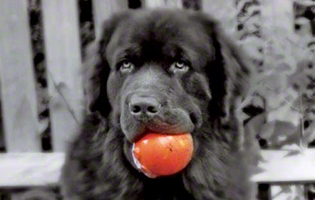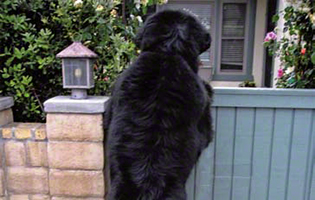One well-known joint ailment among Newfs is hip dysplasia, but joint change can occur in any joint. Genetic flaws, injuries, poor diet, addition of supplements to diets, inadequate or excessive exercise – any of this can initiate or contribute to the development of joint disease.
From the OFA web site: Hip Dysplasia is a terrible genetic disease because of the various degrees of arthritis (also called degenerative joint disease, arthrosis, osteoarthrosis) it can eventually produce, leading to pain and debilitation. From the PennHip web site: Abnormal development of the hip causes excessive wear of the joint cartilage during weight bearing, eventually leading to the development of arthritis, often called degenerative joint disease (DJD) or osteoarthritis (OA). For Newfoundlands, elbows are an even more serious area for joint disease, since dogs carry most of their weight on their front end.
The structure and physiological maintenance of a joint is rooted in genetics. Learning is slowly unfolding about the complex genetics of inheritance and about the process of change in the joint. The occurrence of degenerative changes on the right side may be independent from those on the left side. While genetics is the primary factor, an injury can also lead to arthritic change in a joint. Anything that increases inflammation can initiate or further the degree of change. For hips, laxity in the joints and a shallow acetabulum will probably lead to degenerative joint disease (DJD) at some point. However, radiographic evidence of change may not correlate with symptoms. Some dogs do not show that they experience pain even when DJD is present. There are a number of dysplastic dogs with severe arthritis who have normal activity and some dogs with little evidence of change on radiographs who are severely lame. This can make it a challenge to associate lameness with the area of joint change. However, x-ray equipment is improving and the ability to interpret x-rays for different areas of joint disease is improving as well. Some areas of lameness, such as the spine, can be difficult to impossible to evaluate using x-rays alone. And, since Newfoundlands tend to be stoic about pain, this can make it difficult to determine which area(s) to x-ray. It’s not always the hips that cause lameness!
To optimize the development of sound joints, owners should keep a close eye on the weight gain of a growing Newfoundland. Excess weight increases the risk that DJD will develop. Maintaining good muscle will also help support developing joints. Should an injury occur, restricting activity for a period may be all that’s required to allow healing. Sometimes anti-inflammatory medications are needed, but these can have serious side effects. Any mild lameness that continues for multiple days or any significant or incapacitating lameness should be evaluated by a veterinarian who is skilled in orthopedic evaluation. Delay can allow a problem to grow worse.
These are some common causes of injury related to joint inflammation and development of joint disease:
• Jumping out of vehicles or off platforms, particularly onto hard surfaces – the impact on elbows can result in fractures or DJD or tendonitis. Newfoundlands tend to carry a large proportion of their weight on their front end, so arthritic change in their elbows can be debilitating.
• Falling or sliding on a slick floor – this can result in ligament tears in any joint
• Rough play with other large dogs – body slams and “spins” can result in back injuries, another “game” is arm-grabbing which can result in fractures
Puppies need to play with other dogs to learn social behaviors. However, an overly excited puppy or playmate may not use good judgment when playing with other dogs, chasing a toy, etc. Teaching calm behavior can help reduce the risk of a calamity. At around 6 months, your puppy is reaching an age where he is beginning to feel that invincibility factor. This will continue for quite a while, as he becomes quite impressed with his newfound physical abilities without understanding his physical limitations.
A breed- and age-appropriate diet and weight management are good ways to optimize the development of sound joints, along with appropriate exercise. Walking and swimming are good forms of exercise to build up muscles that support joints. Walks that include climbing up and down hills are especially good, and natural surfaces tend to be better for reducing impact than walking on sidewalks. By 6 months of age, with regular exercise, your puppy should be up to at least 20 minutes of walking. When the temperature is 65 or above and the humidity is significant, frequency is more important than distance, and natural surfaces other than rocks tend to hold less heat.

